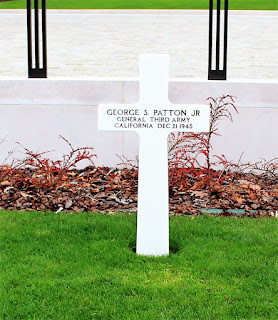 |
| The grave marker for General George S Patton Jr. Though he died several months after the war ended, his wife Beatrice insisted that he be buried with them men he commanded. |
Luxembourg American Cemetery covers more than 50 acres and is the resting place of 5,076 service members from World War II. This means that the American population buried here is equivalent to .8% of the entire country of Luxembourg.
Incredibly, there are 22 instances of brothers being buried adjacent to each other. In a profession where burial next to anyone wearing the same uniform is akin to being buried next to a brother, the idea of blood relatives buried together an ocean away from home is even more comforting.
What is not comforting to me is that in every single cemetery I have visited is the number of people on the wall that honors the missing from the region. Some of them may be in the "unknown" graves. However too many others likely rest in unmarked graves, or quite honestly there was just nothing left of them to bury after a gruesome demise on the battlefield and they are forever missing. This is by far the most emotional part of each visit I make.
 |
| Each American cemetery has a list of the missing soldiers from that theater of battle. The wall in Luxembourg is uniquely large given the extent and nature of the fight that took place in Bastogne. |
In Europe it is very rare for a cemetery to be a quiet place. They are usually located in the center of towns and business centers that are congested with people and traffic. The American military cemeteries are the exception to this rule. The majority of them are located in isolated, quiet and serene surroundings. The Luxembourg American Cemetery is no different, except for the occasional aircraft rumbling down the runway of the adjacent airport.
The vast majority of Soldiers buried in Luxembourg died in the famous Battle of the Bulge in the nearby Ardennes Forest area around Bastogne, Belgium. This was the location of some of the most fierce fighting on the Western Front of World War II. The allies suffered more than 100,000 casualties including 19,000 Americans killed in action. The Americans were supported by English and Canadian allies who also took significant losses in the hardest two months of fighting between December 1944 and January of 1945.
I will delve more deeply into the Battle of the Bulge after my visit to the battlefields next week. If you are interested in getting a taste of the Battle of the Bulge and the chaotic fighting that occurred there, I encourage you to check out two episodes (Bastogne and The Breaking Point) of the 2001 HBO mini series Band of Brothers. The series tells the story of E Company, 2 Battalion, 506th Parachute Infantry Regiment. These particular episodes give good insight into what many of the Soldiers buried in this cemetery experienced in the woods of the Ardennes in Eastern Belgium and Luxembourg. This cemetery is home to a large number of the casualties from that unit, including several that were featured in the TV series.

No comments:
Post a Comment